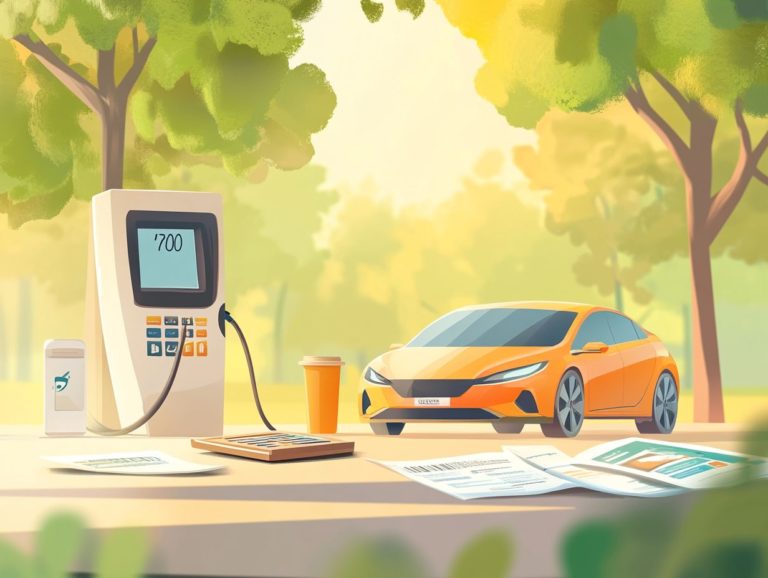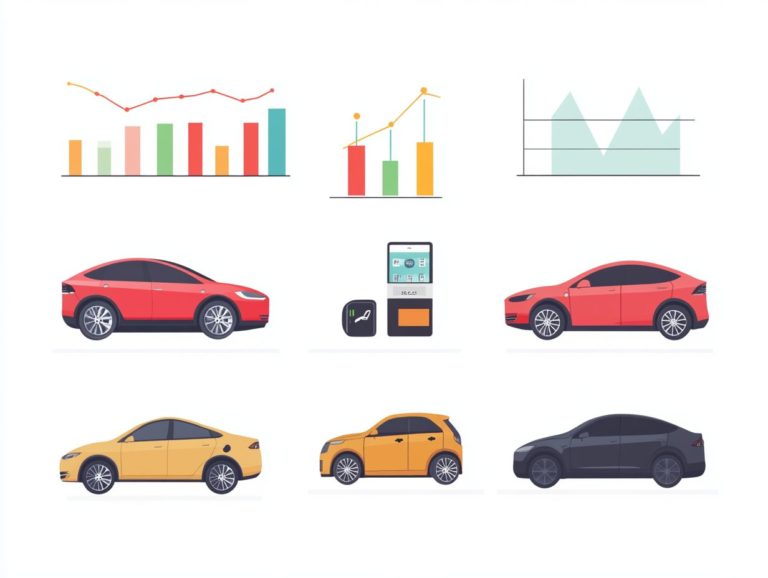5 essential tips for claiming ev rebates
Navigating the world of electric vehicle (EV) rebates can feel overwhelming. However, grasping the process is essential for maximizing your savings.
This guide presents five tips to help you claim EV rebates. From understanding eligibility to exploring rebate types, we’ve got you covered.
Uncover the benefits of claiming rebates. Learn strategies to maximize your claim and debunk common misconceptions.
Are you ready to optimize your EV investment? Let s dive in!
Contents
- Key Takeaways:
- 1. Know the Eligibility Criteria for EV Rebates
- 2. Understand the Different Types of EV Rebates
- 3. Research and Compare Available Rebates
- 4. Keep Track of Deadlines and Requirements
- 5. Be Prepared to Provide Necessary Documentation
- What Are the Benefits of Claiming EV Rebates?
- Frequently Asked Questions
- What are the 5 essential tips for claiming EV rebates?
- How do I check the eligibility requirements for EV rebates?
- What documents do I need to gather for claiming EV rebates?
- What should I do if I miss the deadline for submitting my EV rebate application?
- How can I follow up with the rebate program after submitting my application?
- Can I use the EV rebate towards any electric vehicle purchase?
Key Takeaways:

Know eligibility criteria for EV rebates to ensure you qualify before applying.
Understand the different types of EV rebates available to find the best fit for you.
Research and compare available rebates to maximize your potential savings.
1. Know the Eligibility Criteria for EV Rebates
To tap into the benefits of the Inflation Reduction Act, it’s crucial to understand the eligibility criteria for EV rebates. Your eligibility depends on factors like adjusted income and vehicle price limits.
The IRS has set income limits at $150,000 for single filers and $300,000 for joint filers. This ensures higher-income earners don’t dominate these benefits.
New electric vehicles have a price cap at $55,000, while SUVs and trucks are capped at $80,000. While the Chevy Bolt EV often qualifies, assess higher-end models from Tesla to see if they remain eligible.
Used vehicles can also qualify, as long as their price is below $25,000. Understanding these details is key to maximizing your savings through tax credits.
2. Understand the Different Types of EV Rebates
Various EV rebates are available, including the tax credit for new electric vehicles, used EV tax credit for pre-owned models, and clean vehicle tax breaks for commercial EVs. Each offers unique credit limits and eligibility criteria based on vehicle price.
The EV tax credit for new vehicles can provide up to $7,500, depending on battery capacity. Meanwhile, the used EV tax credit generally offers up to $4,000 for qualifying models under a certain price threshold.
For commercial EVs, there are programs to assist businesses in transitioning their fleets. These come with specific requirements like vehicle weight and usage primarily for business.
To maximize your benefits, dive into the specifics of each program.
3. Research and Compare Available Rebates
Researching and comparing EV rebates is crucial for maximizing your savings. Resources like Fueleconomy.gov and IRS guidelines provide detailed information on various incentives, including 5 ways EV incentives can save you money.
Using these resources gives you insights into federal, state, and local rebates. Understanding how to navigate EV rebates in different states can significantly reduce your vehicle’s purchase price and ongoing costs like charging and maintenance.
Staying informed about current rebate programs enables you to make the best decisions. Fully leverage all available discounts and incentives to maximize your savings!
4. Keep Track of Deadlines and Requirements

Keeping track of deadlines and requirements is essential for claiming the EV tax credit or clean vehicle tax break. The IRS sets specific timelines and credit limits based on the type of electric vehicle you purchase.
If you want to claim these credits, you need to submit your applications by a specific date each tax year. Missing this deadline could lead to penalties, something you want to avoid.
Gather and submit accurate documentation. This includes purchase agreements and proof of residency, as there can be differences for personal and commercial electric vehicles.
For personal use, standard passenger cars may have different requirements compared to vans or trucks designed for business operations. Ensuring that all your paperwork is in order facilitates a smoother process and helps you grasp the specific benefits associated with various vehicle classifications.
5. Be Prepared to Provide Necessary Documentation
Being well-prepared with the necessary documentation is vital for successfully claiming the EV tax credit. You ll need to submit your IRS tax return alongside Form 8936 to verify your eligibility and determine the applicable credit amount based on your purchase of either used electric vehicles or new clean vehicles.
This requirement highlights the importance of keeping careful records for anyone eager to benefit from the incentives tied to electric vehicles. By maintaining accurate documentation, you can streamline your filing process and ensure that you receive the maximum credit you deserve.
The details you provide in Form 8936 can vary significantly, especially when distinguishing between new and used models, which directly impacts the credit amount awarded. Having thorough documentation not only supports your claims but is also essential in avoiding potential audits and ensuring compliance with IRS stipulations.
What Are the Benefits of Claiming EV Rebates?
Claiming EV rebates offers you a wealth of advantages, from substantial savings on electric vehicles to significant reductions in upfront costs through the EV tax credit and how to apply for electric vehicle rebates and clean vehicle tax breaks.
Excitingly, these incentives also apply to commercial EVs, making your switch to cleaner transport easier than ever while adhering to IRS battery capacity requirements.
These incentives lower the total purchase price, making electric vehicles more accessible for everyone, and promote environmentally conscious decisions among consumers and businesses alike.
By alleviating the financial burden of owning an electric vehicle, these rebates encourage a shift toward sustainable commuting methods.
For commercial entities, tailored rebates for business vehicles can enhance savings, particularly when the vehicles meet the minimum battery capacity requirements, thus maximizing your potential for incentives.
In this way, EV rebates act as a vital stepping stone toward a greener future, providing both economic and environmental benefits.
What Are the Common Misconceptions About EV Rebates?
Common misconceptions about EV rebates can lead to misunderstandings regarding eligibility criteria for the EV tax credit. Many believe it only covers new electric vehicles, missing out on great options for commercial and used EVs.
This narrow view fails to recognize the myriad of incentives available for a wide array of electric mobility options, including both commercial fleets and pre-owned models. Many consumers remain blissfully unaware that numerous local and state programs can further enhance these benefits, making electric vehicles more accessible to a diverse range of buyers.
By taking the time to educate yourself on the full spectrum of incentives, you can navigate the sometimes confusing landscape of rebates and grants with ease. This knowledge ultimately unlocks a wealth of financial support that can significantly influence your investment decisions.
Don t miss out! Dive into the world of EV rebates and start saving today!
How Can EV Rebates Help with the Cost of Owning an Electric Vehicle?

EV rebates can significantly lighten the financial load of owning an electric vehicle. The EV tax credit and clean vehicle tax break offer valuable incentives that help offset the initial purchase price. This ultimately leads to considerable savings and encourages more people to embrace electric vehicles.
In practical terms, these incentives can translate into substantial savings over time. For example, buying an electric vehicle could qualify you for a federal tax credit of up to $7,500, depending on the model and its price. Imagine this: if you purchase a $40,000 EV, your effective cost could drop to just $32,500.
State-level incentives can sweeten the deal even further, sometimes adding another $5,000 or more in rebates. Keep in mind that income and vehicle price limits can affect your eligibility. This might prompt you to evaluate your options carefully.
Understanding these financial benefits empowers you to make smart, money-saving choices for your next vehicle!
What Are the Potential Drawbacks of Claiming EV Rebates?
Claiming EV rebates offers substantial benefits, but it’s important to be aware of potential drawbacks. Strict eligibility requirements and credit limits imposed by the IRS could disqualify you or limit the rebate amount you receive. For more information, consider understanding the process for EV rebates.
For instance, you might find yourself unable to access these incentives due to your income level or the specific vehicle model you re considering. This can be a frustrating hurdle for many, especially those interested in used electric vehicles that may not meet the high-efficiency standards required by the rebate program.
You might feel discouraged if the rebate only covers a small portion of the total cost, making it harder to justify that upfront investment in an electric vehicle. This situation complicates the transition to greener alternatives and could impact the broader adoption of electric mobility solutions.
What Are the Long-Term Savings of Owning an Electric Vehicle?
Owning an electric vehicle can lead to significant long-term savings, thanks to the EV tax credit and clean vehicle incentives that reduce those initial purchase costs. These incentives also help keep fuel and maintenance expenses in check over time.
In fact, you could save more than $1,000 each year just on fuel, considering the differences between electricity and gasoline prices.
Electric vehicles usually come with lower maintenance costs, saving you around 30% compared to traditional gas-powered cars. This is due to fewer moving parts and the delightful absence of oil changes.
Federal tax credits can slash your upfront costs by up to $7,500. Switching to electric is not only a win for the environment but also a savvy financial decision.
All these factors come together to create a compelling case for the economic benefits of embracing electric vehicles.
How Can One Maximize Their EV Rebate Claim?
Maximizing your EV rebate claim hinges on a clear understanding of IRS guidelines and eligibility requirements. This knowledge helps you secure the highest credit amount possible and enables you to leverage EV rebates for savings on both new and used electric vehicles.
To achieve this, closely scrutinize the specific qualifications outlined by the IRS. Pay attention to the required forms and documentation for your claim. Timing your purchase wisely is equally important; if you re considering an electric vehicle, be mindful of tax year deadlines to get the best rates.
Explore local and state incentives to enhance your rebate. For new models, these incentives can vary considerably, while used electric vehicles may qualify for distinct tax benefits. To maximize your savings, check out the top 10 EV rebates you should know about. This strategic approach allows you to optimize your financial savings effectively.
Frequently Asked Questions

What are the 5 essential tips for claiming EV rebates?
The 5 steps to claim your EV incentives are essential tips for claiming EV rebates: check eligibility requirements, gather necessary documents, submit the application on time, follow up with the rebate program, and use the rebate towards your EV purchase.
How do I check the eligibility requirements for EV rebates?
Check eligibility requirements for EV rebates by visiting the rebate program’s website. You can also contact their customer service for assistance.
What documents do I need to gather for claiming EV rebates?
The documents needed for claiming EV rebates can differ by program. Common items include proof of EV purchase or lease, vehicle registration, and what you need to know about EV purchase rebates, including proof of residency.
What should I do if I miss the deadline for submitting my EV rebate application?
If you miss the application deadline, you may lose your chance for the rebate. Contact the rebate program to explain your situation; they might have exceptions for valid reasons.
How can I follow up with the rebate program after submitting my application?
Follow up by checking your application status on their website or by contacting customer service. It s best to do this within a week or two to ensure your application is moving forward.
Can I use the EV rebate towards any electric vehicle purchase?
The use of EV rebates depends on the program. Some allow the rebate on any electric vehicle, while others have restrictions on the make, model, or year. Check the terms and conditions to make sure you re covered!






